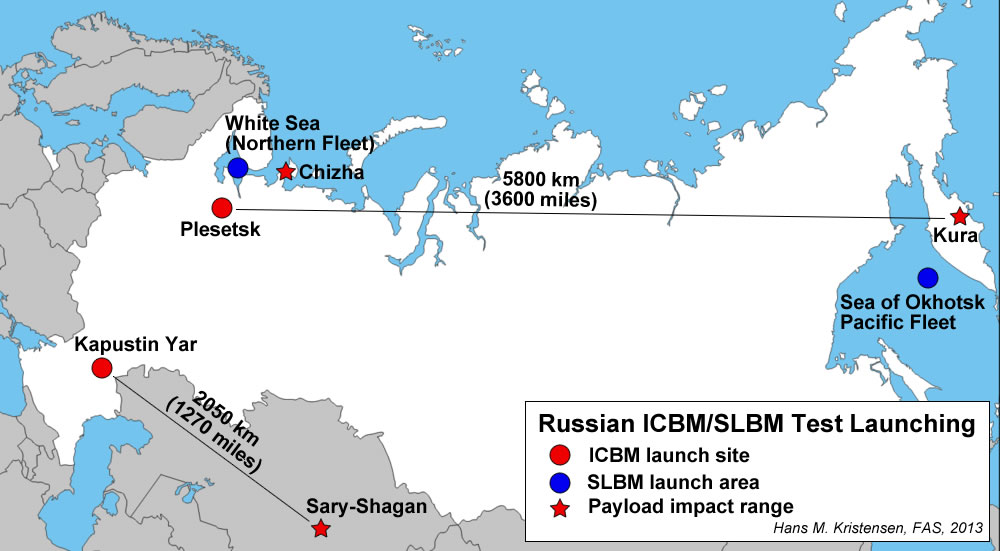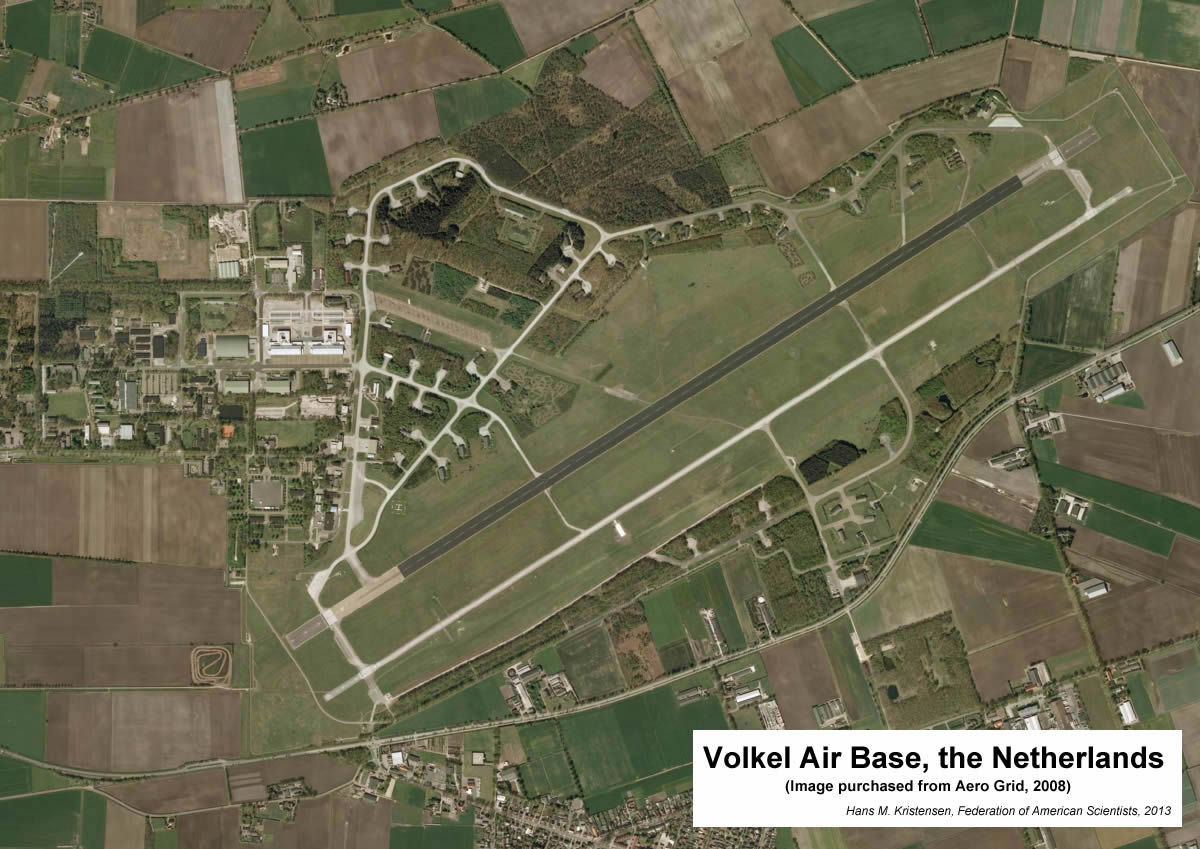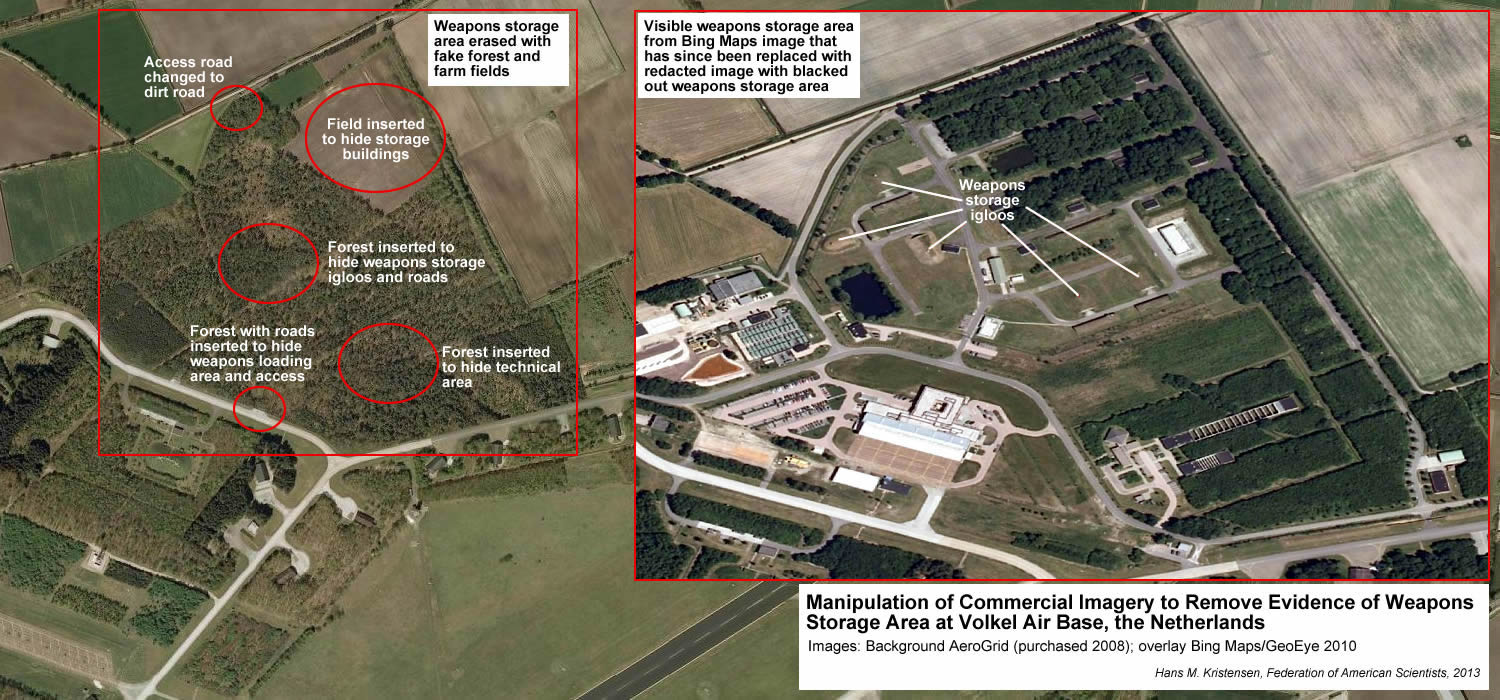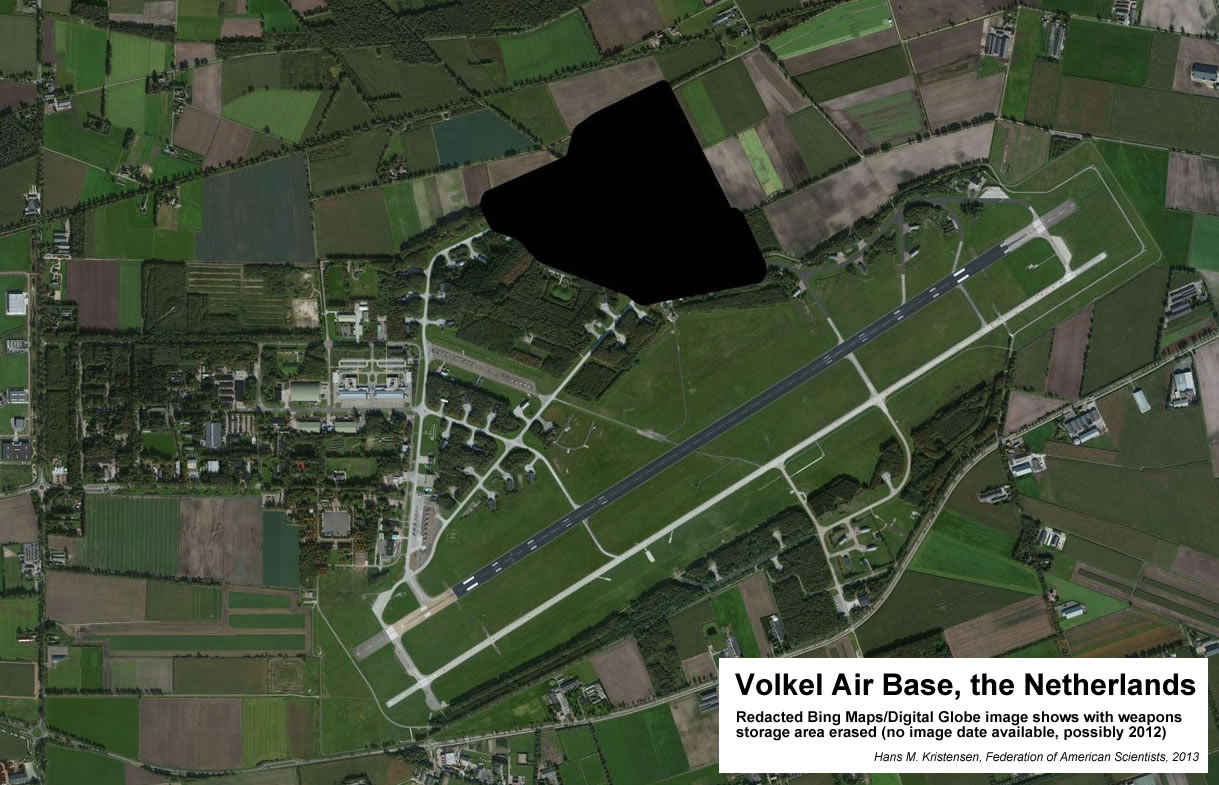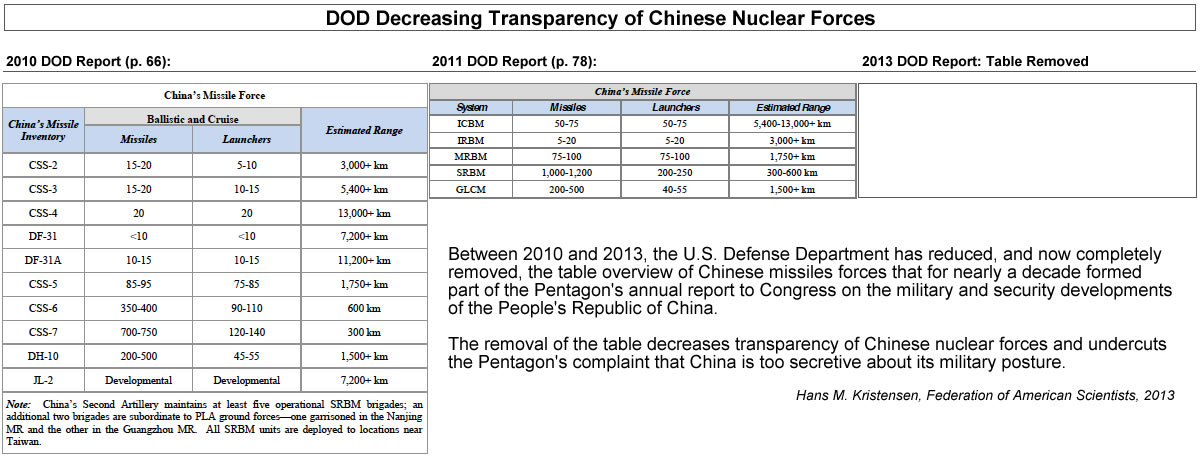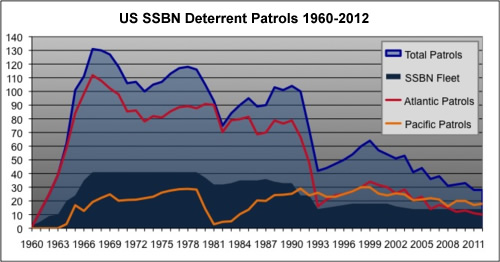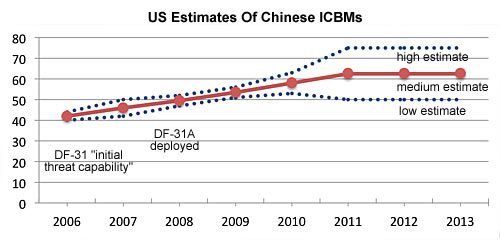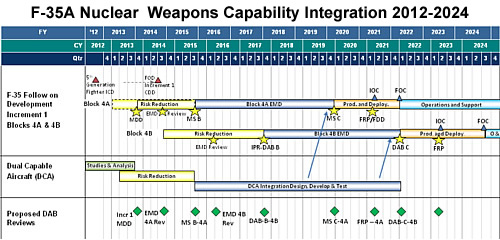SSBNX Under Pressure: Submarine Chief Says Navy Can’t Reduce
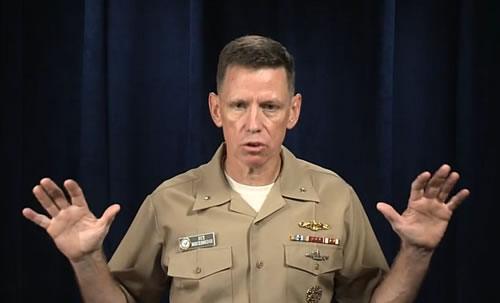
The head of the SSBN fleet, Rear Admiral Richard Breckenridge, says the size of the fleet is really about geography.
By Hans M. Kristensen
In a blog and video on the U.S. Navy web site Navy Live, the head of the U.S. submarine force Rear Admiral Richard Breckenridge claims that the United States cannot reduce its fleet of nuclear ballistic missile submarines further.
This is the third time in three months that Breckenridge has seen a need to go online to defend the size of the SSBN fleet. The first time was in May in reaction to my article about declining SSBN patrols. The second time was in June when he argued that the design chosen for the next-generation SSBN was the only option.
Now Breckenridge argues that the number of operational SSBNs cannot be reduced further if the U.S. Navy is to be able to conduct continuous deployments in the Pacific and Atlantic oceans.
Three public interventions in as many months shows that the plan to spend $70 billion-plus to build a new class of 12 SSBNs is under pressure, and Breckenridge acknowledges that much: “The heat inside the Pentagon right now is probably just as bad” as the summer heat outside and “with sequestration and the fiscal crisis and the budgetary impacts on the DOD topline, there’s a lot of folks looking at how low we can go with the SSBN force.”
But the 12 planned next-generation SSBNs “is the floor,” Breckenridge claims.
A Matter of Geography
It is not the first time that the navy has argued that what it has or plans to build is the absolute minimum and that anything less would undermine U.S. national security. But why does the navy plan to build 12 new SSBNs?
The answer, Breckenridge says, “really is a matter of geography.”
“For us to be able to conduct two-oceans strategic deterrence requires a bare minimum number of SSBNs of a force of twelve,” he claims. To get to that number, Breckenridge begins with a series of broad assumptions and claims about deterrence and SSBN operations.
“There are two important points for you to know for how strategic deterrence works. The first is those SSBNs have to invincible. They have to be survivable at sea. The adversary can’t find them. Hidden and unable to be detected. And second, they have to be within range of targets that matter to the adversary, that we can hold at risk to deter or dissuade them from ever considering attacking our homeland.”
“Geography requires that 60-40 split of our SSBN force,” he says. “A few more in the Pacific than in the Atlantic to be able to meet those two criteria for our nation’s defense.”
I May Not Know Much About Geography, But…
That explanation might work well for a public relations sound bite, but I hope the Pentagon folks examining the SSBN force level probe a little deeper.
First of all, why does two-oceans strategic deterrence require 12 SSBNs? Three decades ago it required 41. Two decades ago it required 33. One decade ago it required 18. Now it requires 14. And in two decades it will still require 12 SSBNs, according to the navy.
Breckenridge explains that out of 14 SSBNs currently in the fleet, 11 are on average operational but it sometimes drops to 10, with the rest undergoing maintenance (see here for article about SSBN operations). Those 10 operational SSBNs (six in the Pacific and four in the Atlantic) “is the bare minimum required to provide uninterrupted alert coverage for the combatant commander,” according to Breckenridge.
He says that the current SSBN fleet is a “lean” force. But there is nothing lean about it: the fleet is bigger than that of any other country; each Ohio-class SSBN carries more missiles than any SSBN of any other country can carry; each Trident II D5 missile can be loaded with more warheads than SLBMs of any other country; each missile is more accurate, lethal, and reliable than any other country’s SLBM; and the U.S. SSBN fleet conducts three times more deterrent patrols than any other country. The force is bloated both in terms of size, loadout, capability, and operations.
Britain and France both manage to ensure their security each with four SSBNs operating from a single base. In contrast, the “bare minimum” force that Breckenridge advocates of 10 deployable next-generation SSBNs will be able to carry 160 SLBMs with up to 1,280 warheads – more than Britain, France, China, Pakistan, India and Israel have in their total stockpiles, combined! In fact, that 10-SSBN force would be able to carry more than the entire deployed strategic warhead level proposed by President Obama in his recent Berlin speech.
Like Russia’s future SSBN fleet, the U.S. Navy could easily operate eight SSBNs from two bases. That would ensure that six next-generation SSBNs would always be deployed or ready to deploy on short notice. Combined they would be armed with nearly 100 long-range missiles capable of carrying up to 760 warheads that can hold a risk the full range of targets. Try to put 760 Xs – even 100 – on a map of Russia or China and tell me why that would be insufficient for deterrence in this day and age.
Equally important, where does the requirement to provide “uninterrupted alert coverage” on such a scale come from? What is the scenario? And why is it necessary – more than two decades after the end of the Cold War – “to provide uninterrupted alert coverage for the combatant commander”?
The requirement comes from the nuclear strategists that create the objectives and tasks that military planners translate into a “family” of nuclear strike plans against half a dozen adversaries. Those requirements are what Breckenridge is trying to meet with his 12 SSBNs.
But there is nothing in the strategic threat environment of today’s world that requires U.S. SSBNs to “provide uninterrupted alert coverage” under normal circumstances. Indeed, the new nuclear weapons employment policy issued by the White House last month concluded that “the potential for a surprise, disarming nuclear attack is exceedingly remote” and ordered DOD to “reduce the role of launch under attack” in nuclear planning.
Consequently, the SSBNs could be taken off alert and their readiness level significantly reduced while still providing basic operational training to the crews. The annual number of SSBN deterrent patrols has already declined by more than half over past decade and may drop further in the next years.
The Pentagon is already so confident in the capability of the SSBN fleet that it has concluded that Russia “would not be able to achieve a militarily significant advantage by any plausible expansion of its nuclear forces” because it would have “little to no effect” on the U.S. ability to retaliate with a devastating strike.
Despite Russian modernizations, the size of its strategic force is declining and will continue to decline over the next decade with or without a new arms reduction agreement. And there is no indication that China, despite its own modernizations, is planning to increase the size of its strategic nuclear force to anything remotely comparable to the force level proposed by President Obama.
Yet for the next two decades, until 2031 when the first next-generation SSBN is scheduled to sail on patrol, the navy plans to continue to operate all 14 Ohio-class SSBNs. Of those, the 12 operational boats currently carry 288 Trident II D5 missiles, which will be reduced to no more than 240 deployed missiles by 2018 under the New START Treaty. But that is 80 missiles (50 percent) more than the 160 missiles that will be deployed on the 10 operational next-generation SSBNs.
Why does the navy plan to sail for two decades with 50 percent more missiles than it has already decided it can do with on the next-generation SSBN?
This is even more puzzling because the plan for 12 SSBNs with 16 missiles each “did not assume any specific changes to targeting or employment guidance,” STRATCOM commander Robert Kehler testified before Congress in November 2011.
Read that again: the significant reduction planned for deployed sea-launched ballistic missiles did not require any specific changes to targeting or employment guidance!
That statement indicates that there is significant excess capacity on the SSBN fleet. And it is mind-boggling that Congress did not even notice it.
Conclusions and Recommendations
I may not know much about geography but it appears the SSBN force is significantly in excess of what is required now or planned for later. A force of 8-10 SSBNs with six operational boats would provide more than enough capacity to perform adequate deterrence deployments in Pacific and Atlantic.
Shedding the excess SSBN capacity now would save billions of dollars in construction and operational costs and make it easier to persuade Russia to reduce it forces as well. That seems to be a double win.
Part of the problem with debating SSBN operations and the war plans they are tasked under is that everything is so secret that there essentially is no way to independently verify Breckenridge’s claims. All we have are bits a pieces and common sense.
And because of this secrecy, and the almost religious aura of legitimacy that the SSBN force enjoys, many lawmakers blindly accept the claims and do not question the size of the force or the assumptions for its operations. That ends up costing the U.S. taxpayers billions of dollars.
The issue facing us is not whether the SSBN force provides an important contribution to U.S. national security or not. It does. The issue is what composition it needs to have and how it needs to operate to provide sufficient security at an affordable price.
Russian Missile Test Creates Confusion and Opposition in Washington
The recent test-launch of a modified Russian ballistic missile has nuclear arms reduction opponents up in arms with claims that Russia is fielding a new missile in violation of arms control agreements and that the United States therefore should not pursue further reductions of nuclear forces.
The fact that the Russian name of the modified missile – Rubezh – sounds a little like rubbish is a coincidence, but it fits some of the complaints pretty well.
Although many of the facts are missing – what the missile is and what the U.S. Intelligence Community has concluded – public information and statements indicate that the missile is a modified RS-24 Yars (SS-27 Mod 2) with intercontinental range.
Whatever the missile is, it is certainly no reason for why the United States should not seek to reduce U.S. and Russian nuclear forces further. On the contrary, the continued modernization of nuclear weapons underscores why it is important that the United States continues its push for reducing the numbers and role of nuclear weapons.
The Accusations
Under the headline “Russian Aggression: Putin violating nuclear missile treaty,” the article on Washington Times Free Beacon web site accuses Russia of being engaged in “a major violation” of the terms of the Intermediate-range Nuclear Forces (INF) Treaty signed with the United States in 1987.
The treaty bans all nuclear ground-launched ballistic and cruise missiles with range between 500 and 5,500 km (about 300-3,400 miles).
Claims of Russian cheating are frequent in the Washington arms control debate – just as claims about U.S. cheating is frequent in the Moscow arms control debate – and the ones in the article are largely consistent with the claims made by Mark Schneider, a former DOD official and now with the National Institute for Public Policy.
The “new” in the article is that it quotes “one official” saying: “The intelligence community believes it’s an intermediate-range missile that [the Russians] have classified as an ICBM because it would violate the INF treaty.” In total, “Two U.S. intelligence officials said the Yars M is not an ICBM,” according to the article.
Two members of Congress, House Armed Services Committee chairman Howard “Buck” McKeon (R-CA) and House Permanent Select Intelligence Committee chairman Mike Rodgers (R-MI), have written President Obama about alleged Russian violations. They complain that they haven’t received a response but the administration says it deals with treaty compliance issue directly with Russia and informs Congress accordingly.
Accusations Disputed
The accusations that the Yars-M is not an ICBM and in violation of the INF Treaty are disputed by Russian officials and, interestingly, previous flight tests of the missile itself.
To its credit, the Washington Times took the trouble of asking Colonel General Victor Yesin about the missile. Yesin is former Chief of Staff of the Russian Strategic Rocket Forces and apparently a consultant to the Chief of the General Staff. But Yesin clearly disputed the claim by the U.S. intelligence officials, saying that the Yars-M is a “Topol-M class ICBM” and that “its range is over 5,500 km.”
That assessment fits the description made by a source in the General Staff in November 2012, following the first Yars-M launch from Kapustin Yar in October 2012 and news media rumors that Russia was developing a “fundamentally new missile.” “There are no fundamentally new missiles ‘on the approach’ for [the Russian Strategic Rocket Forces]. We are talking about modernizing the existing Yars class by improving the warhead,” he told Interfax and explained:
“Take the Layner [modification of the SS-N-23] sea-based intercontinental ballistic missile, reported by some media to be a completely new missile. It is in fact a Sineva. Only the warhead is new. Novelty lies in greater missile defense penetration capabilities, achieved owing to, among other things, a greater number of re-entry vehicles (boyevoy blok) in the warhead. The same applies to the prototype missile that was successfully launched from Kapustin Yar (Astrakhan Region) recently. There is nothing new in the missile itself. Only the ‘head’ is new. Its creators went down the same route as the designers of the Layner.”
Moreover, the claim that the short flight range of the missile test launched from Kaputsin Yar in June 2013 would indicate that the Yars-M is not an ICBM ignores that an earlier flight test of the missile last year flew 5,800 kilometers from Plesetsk north of Moscow to the Kura test range on the Kamchatka Peninsula (see table).
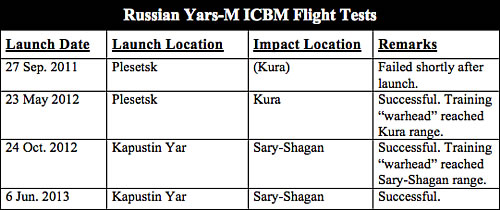
After the May 2012 flight test, Colonel-General Vladimir Zarudnitsky of the General Staff said: “As part of the approved plan of your building the armed forces of the Russian Federation last night made a promising test launch rocket system” Frontier “with an intercontinental ballistic missile high-precision shooting.” (Emphasis added).
Col. Vadim Koval, a Russian defense ministry spokesperson, said “the main goals and tasks of the launch consisted of receiving experimental data on confirming the correctness of the scientific-technical and technological decisions in developing the intercontinental ballistic missile as well as checking the performance and determining the technical characteristics of its systems and components.” (Emphasis added).
Rather than an entirely new missile, Koval explained further, “This missile is being created by using and developing, to the maximum extent, already existing new capacities and technological solutions, which were obtained in the development of fifth generation missile complexes, which substantially reduces the terms and expenditures on its creation.”
After the successful initial launch from Plesetsk, the second test was moved to Kapustin Yar apparently to test the capability of the Yars-M payload to evade ballistic missile defense systems. An industry sources told Interfax that, “The use of new fuel is one of the features of the missile. It reduces boost phase engine operation time. Consequently, the missile’s capabilities to penetrate missile defense will go up.”
It is rare, but not unheard of, that ICBMs are launched from Kapustin Yar into the Sary-Sagan test range. It appears to happen when ICBM payloads are being tested against missile defense systems. In addition to the recent tests of the modified SS-27, an SS-25 was test launched from the site on June 7, 2012. The test flight verified the “extended service life” of the SS-25 and “the latest test of an ICBM combat payload.” During the test “information was received which in future will be used in the interests of developing effective means for overcoming missile defense,” according to the Russian Ministry of Defense.
After the June 2013 test, Deputy Prime Minister Dmitry Rogozin, called the modified SS-27 a “missile defense killer.”
It is not unusual that ballistic missiles with intercontinental range are test-flown in a compressed trajectory with much shorter range. That doesn’t make them less than strategic weapons, however. In March 2006, for example, the U.S. Navy launched a Trident II D5 sea-launched ballistic missile with a range of well over 7,400 kilometer (4,000 miles) in a compressed trajectory of 2,200 kilometers (1,380 miles) – about the same range as the Yars-M test on June 6, 2013. No one has suggested that the Trident II D5 therefore is an INF weapon.
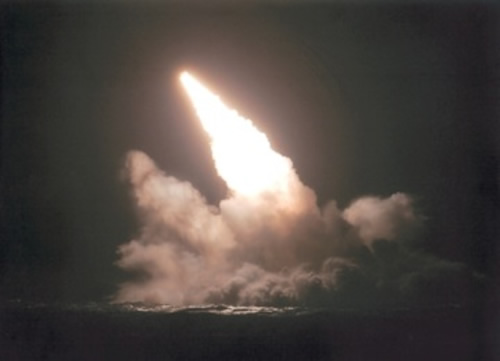
The USS Tennessee (SSBN-734) launches a Trident II D5 SLBM on March 2, 2005, on a compressed trajectory of only 2,200 km – about the same range as the Yars-M test in June 2013.
Conclusions and Recommendations
If there are Russian violations of the INF Treaty, then the United States certainly should raise it directly with Moscow.
But the claim that the Yars-M missile flight-tested on June 6 to a range of 2,050 kilometers is an intermediate-range ballistic missile in violation of the INF treaty seems strange since the same missile apparently was flight tested to an ICBM range of 5,800 kilometers just a year ago.
Of course, we don’t know who the U.S. intelligence officials cited in the Washington Times article are, if what they say is accurate, and to what extent it reflects a coordinated assessment by the U.S. Intelligence Community. We may learn more about the Yars-M in the future.
But several Russian government, military, and industry officials have consistently stated that the Yars-M is not a new missile but a modification of the RS-24 Yars (SS-27 Mod 2) and that it has intercontinental range.
The intension of the allegations in the article seems clear: to create doubts about further reductions of U.S. nuclear forces. One of the “officials” quoted in the article directly questions: “How can President Obama believe [the Russians] are going to live up to any nuclear treaty reductions when he knows they are violating the INF treaty by calling one of their missiles something else?”
The thought that Americans would use INF treaty allegations to argue against reducing the number of strategic nuclear weapons that can hit the United States seems kind of bizarre. After all, under current Russian war plans, many of the 400-500 warheads President Obama has proposed can be offloaded under a new agreement, are most likely currently tasked to hold at risk several hundred targets in the United States – including some in California and Michigan.
Since Russia – unlike the United States – is already below the New START Treaty limit on deployed nuclear weapons and likely to drop further before the treaty enters into force in 2018, it seems like a no-brainer that it is in the U.S. interest to nurture that trend by reducing its own forces further.
This is even more important because the very reason some Russian officials could potentially be tempted to argue that an INF-missile was needed is that China is modernizing of its medium-range missile forces. Ironically, many of those in the United States who make the accusations about Russian INF violations are the same people who also warn about China’s nuclear modernization.
What the article completely seems to miss is that the only way that China and smaller nuclear weapons states may be persuaded to place limits on their nuclear arsenals is if the United States and Russia take bold steps to reduce their still enormous nuclear arsenals. Why then nitpick about dubious INF accusations to block that from happening?
This publication was made possible by grants from the New-Land Foundation and Ploughshares Fund. The statements made and views expressed are solely the responsibility of the author.
New Nuclear Weapons Employment Guidance Puts Obama’s Fingerprint on Nuclear Weapons Policy and Strategy
President Barack Obama’s Berlin speech failed to capture the nuclear disarmament spirit of the Prague speech four years ago. And no wonder. Back then Obama had to contrast with the Bush administration’s nuclear policies. This time Obama had to upstage his own record.
The only real nuclear weapons news that was included in the Berlin speech was a decision previously reported by the Center for Public Integrity that the administration is pursuing an “up to a one-third reduction” in deployed nuclear weapons established under New START.
Instead, the real nuclear news of the day were the results of the Obama administration’s long-awaited new guidance on nuclear weapons employment policy that was explained in a White House fact sheet and a more in-depth report to Congress.
From a nuclear arms control perspective, the new guidance is a mixed bag.
One the one hand, the guidance directs pursuit of additional reductions in deployed strategic warheads and less reliance on preparing for a surprise nuclear attack. On the other hand, the guidance reaffirms a commitment to core Cold War posture characteristics such as counterforce targeting, retaining a triad of strategic nuclear forces, and retaining non-strategic nuclear weapons forward deployed in Europe.
Pursue Additional Reductions
The top news is that the administration has decided that it can meet its security obligations with “up to one-third” fewer deployed strategic warheads that it is allowed under the New START treaty. That would imply that the guidance review has concluded that the United States needs 1,000-1,100 warheads deployed on land- and sea-based strategic warheads, down from the 1,550 permitted under the New START treaty.
It is not entirely clear from the public language, but it appears to be so, that these additional reductions will be pursued in negotiations with Russia rather than as reciprocal unilateral reductions.
Even though the nuclear weapons employment policy would allow for reductions below the New START Treaty levels, it does not direct any changes to the currently deployed forces of the United States. That is up to the follow-on process of the Secretary of Defense producing an updated Nuclear Weapons Employment Policy (NUWEP) appendix to the Guidance for the Employment of the Force (GEF), and the Chairman of the Joint Chiefs of Staff then producing an update to the nuclear supplement to the Joint Strategic Capabilities Plan (JSCP-N).
These updates will inform the Commander of STRATCOM on how to direct the Joint Functional Component Command Global Strike (JFCC-GS) to update the strategic war plan (OPLAN 8010-12), and Geographic Combatant Commanders such as the Commander of European Command to update their regional plans.
So if an when Russia agrees to cutting its deployed strategic warheads by up to one third, it could take several years before President Obama’s guidance actually affects the nuclear employment plans.
Already now, many news articles covering the Berlin speech misrepresent the “cut” by saying it would reduce the U.S. “arsenal” or “stockpile” by one third. But that is not accurate. The envisioned one-third reduction of deployed strategic warheads will not in and of itself destroy a single nuclear warhead or reduce the size of the bloated U.S. and Russian nuclear arsenals.
Reduce Launch Under Attack
The new guidance recognizes, which is important although late, that the possibility of a disarming surprise nuclear attack has diminished significantly since the Cold War. Therefore, the guidance “directs DoD to examine further options to reduce the role of Launch Under Attack plays in U.S. planning, while retaining the ability to Launch Under Attack if directed.”
Launch under attack is the capability to be able to launch nuclear forces after detection that an adversary has initiated a major nuclear attack. Because it only takes about 30 minutes for an ICBM to fly from Russia over the North Pole, Launch Under Attack (LOA) has meant keeping hundreds of weapons on alert and ready to launch within minutes after receiving the launch order.
Barack Obama promised during his election campaign in 2007 that he would work with Russia to take nuclear weapons off “hair-trigger alert,” but the Nuclear Posture Review instead decided to continue the existing readiness of nuclear forces. Now the DOD is directed to study how to reduce LOA in nuclear strike planning but retain some LOA capability.
The guidance does not explicitly say – to the extent it is covered by the DOD report – that nuclear force will be retained on alert. The NPR makes such a statement clearly. The DOD guidance report only states that the practice of open-ocean targeting should be retained so that a weapon launched by mistake would land in the open ocean.
Despite the decision to reduce deployed strategic warheads and reduce Launch Under Attack, the guidance hedges against the change by stating that “the maintenance of a Triad and the ability to upload warheads ensures that, should any potential crisis emerge in the future, no adversary could conclude that any perceived benefits of attacking the United States or its Allies and partners are outweighed by the costs our response would impose on them.”
Counterforce Reaffirmed
The new guidance reaffirms the Cold War practice of using nuclear forces to hold nuclear forces at risk. According to the DOD summary, the new guidance “requires the United States to maintain significant counterforce capabilities against potential adversaries” and explicitly “does not rely on a ‘counter-value’ or ‘minimum deterrence’ strategy.”
This reaffirmation is perhaps the single most important indicator that the new guidance fails to “put and end to Cold War thinking” as envisioned by the Prague speech.
Because “counterforce is preemptive or offensively reactive,” in the words of a STRATCOM-led study from 2002, reaffirmation of nuclear counterforce reaffirms highly offensive planning that is unnecessarily threatening for deterrence to work in the 21st Century. This condition is exacerbated because the reaffirmation of counterforce is associated with a decision to retain – albeit at a reduced level – the ability to Launch Under Attack if directed (see below).
The “warfighting” nature of nuclear counterforce drives requirements for Cold War-like postures and technical and operational requirements that sustain nuclear competition between major nuclear powers at a level that undercuts efforts to reduce the role and numbers of nuclear weapons.
No Sole Purpose…But
Four years after the Nuclear Posture Review decided that the United States could not adopt a sole purpose of nuclear weapons to deter only nuclear attacks, the new guidance reaffirms this rejection by saying “we cannot adopt such a policy today.”
Even so, the guidance apparently reiterates the intention to work towards that goal over time. And it directs the DOD to undertake concrete steps to further reducing the role of nuclear weapons.
Non-Strategic Nuclear Weapons
The decisions regarding non-strategic nuclear weapons are disappointing because they fail to progress the issue. In fact, the White House fact sheet explicitly states that the guidance review did not address forward deployed non-strategic nuclear weapons in Europe.
Even so, the guidance decides to retain a forward-based posture in Europe until NATO agrees it is time to change the posture. The last four years have shown that NATO is incapable of doing so because a few eastern NATO countries cling to Cold War perceptions about nuclear weapons in Europe that blocks progress.
In effect, the lack of initiative now means countries like Lithuania now effectively dictate U.S. policy on non-strategic nuclear weapons.
Hedging Against Hedging
The guidance also directs that the United States will continue to retain a large reserve of non-deployed warheads to hedge against technical failures in deployed warheads.
This both means enough extra warhead types within each leg to hedge against another warhead on that leg failing, as well as keeping enough extra warheads for each leg to hedge against failure of one of the warheads on another leg.
Now that warhead life-extension programs are underway, the guidance directs that DOD should only retain hedge warheads for those modified warheads until confidence is attained. This is a little cryptic because why would the DOD not do that, but the intension seems to be to avoid keeping the old hedge warheads longer than necessary.
Moreover, the guidance also states that all of the hedging against technical issues will provide enough reserve warheads to allow upload of additional warheads – including those removed under the New START Treaty – in response to a geopolitical development somewhere in the world.
This all suggests that we should not expect to see significant reductions in the hedge in the near future but that much of the current hedging strategy will be in place for the next decade and a half.
Conclusions
The Obama administration deserves credit for seeking further reductions in nuclear forces and the role of Launch of Warning in nuclear weapons employment planning. A White House fact sheet and a DOD report provide important information about the new nuclear weapons employment guidance, a controversial issue on which previous administrations have largely failed to brief the public.
The DOD’s report on the new guidance reiterates that it is U.S. policy to “seek the peace and security of a world without nuclear weapons,” but helpfully reminds that “it is imperative that we continue to take concrete steps toward it now.” This is helpful because Obama’s recognition in Prague that the goal of a world free of nuclear weapons might not be achieved in his lifetime has been twisted by opponents of reductions and disarmament to mean an affirmative “not in my lifetime!”
The guidance directs that nuclear “planning should focus on only those objectives and missions that are necessary for deterrence in the 21st century.” The force should be flexible enough, the guidance says, to be able to respond to “a wide range of options” by being able to “threaten credibly a wide range of nuclear responses if deterrence should fail.”
Unfortunately, the public documents do not shed any light on what those objectives and missions are or which ones have been deemed no longer necessary.
Instead, the official descriptions of the new guidance show that its retains much of the Cold War thinking that President Obama said in Prague four years ago that he wanted to put an end to. The reaffirmation of nuclear counterforce and retention of nuclear weapons in Europe are particularly disappointing, as is the decision to retain a large reserve of non-deployed warheads partly to be able to reverse reductions of deployed strategic warheads achieved under the New START Treaty.
In the coming months and years, these decisions will likely be used to justify expensive modernizations of nuclear forces and upgrades to nuclear warheads that will prompt many to ask what has actually changed.
Background: US Nuclear Forces, 2013 – Russian Nuclear Forces, 2013 – Reviewing Nuclear Guidance – From Counterforce to Minimal Deterrence
This publication was made possible by grants from the New-Land Foundation and Ploughshares Fund. The statements made and views expressed are solely the responsibility of the author.
Nukes in Europe: Secrecy Under Siege
By Hans M. Kristensen
 The Cold War practice of NATO and the United States refusing to confirm or deny the presence of nuclear weapons anywhere is under attack in Europe. This week, two former Dutch prime ministers publicly confirmed the presence of nuclear weapons at Volkel Air Base in the Netherlands, one of six bases in NATO that still host US nuclear weapons.
The Cold War practice of NATO and the United States refusing to confirm or deny the presence of nuclear weapons anywhere is under attack in Europe. This week, two former Dutch prime ministers publicly confirmed the presence of nuclear weapons at Volkel Air Base in the Netherlands, one of six bases in NATO that still host US nuclear weapons.
The first confirmation came in the program How Time Flies on the Dutch National Geographic channel where former prime minister Ruud Lubbers confirmed that there are nuclear weapons at Volkel Air Base. “I would never have thought those silly things would still be there in 2013,” Lubbers said, who was prime minister in 1982-1994. He even mentioned a specific number: 22 bombs.
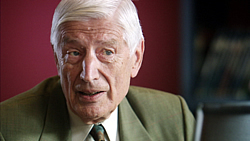 The second confirmation Lubbers was joined yesterday by another former Dutch prime minister, Dries van Agt, who also confirmed that the weapons are there. “They are there and its crazy they still are,” said va Agt, who was prime minister in 1977-1982.
The second confirmation Lubbers was joined yesterday by another former Dutch prime minister, Dries van Agt, who also confirmed that the weapons are there. “They are there and its crazy they still are,” said va Agt, who was prime minister in 1977-1982.
As readers of this blog are aware (and anyone who have followed this issue over the years), it is not news that the US stores nuclear weapons at Volkel AB. But it is certainly news that two former Dutch prime ministers are now confirming it.
It is not a formal Dutch break with NATO nuclear secrecy norms but it is certainly a big crack in the dike that makes the Dutch government’s continued refusal to confirm or deny nuclear weapons at Volkel AB look rather, well, silly.
The instinct of the bureaucracy will be to ignore the statements to the extent possible and retreat into past policies of neither confirming nor denying the presence of nuclear weapons. But the new situation also presents an opportunity to break with the past and attempt to engage Russia about increasing the transparency of non-strategic nuclear weapons in Europe.
Privileged Information
Information about US nuclear weapons at Volkel AB is privileged information that Lubbers and van Agt would have had access to on a highly confidential basis as prime ministers under the bilateral US-Dutch nuclear weapons storage agreement code named Toy Chest (no pun intended).
After leaving office, Lubbers and van Agt would have had to rely on other people with access to such information to be told. A nod would be sufficient to confirm the general presence of weapons, but the specific number would be harder to get. Why Lubbers says 22 is unclear; perhaps that’s the number he recalls from 1994.
Back then, the Clinton administration’s 1994 Nuclear Posture Review decided to retain 480 nuclear bombs in Europe. How many of those were at Volkel AB is unknown, but when President Clinton six years later in December 2000 signed Presidential Decision Directive/NSC-74 that authorized continued deployment of 480 nuclear weapons in Europe, 20 of those were for Volkel AB.
Since then, the United States has unilaterally reduced the stockpile in Europe by nearly 60 percent from 480 to nearly 200 bombs today. Whether the number at Volkel AB has remained the same is unknown. The base has 11 underground storage vaults inside Protective Aircraft Shelters that can house a maximum of 44 bombs (see image). The 22 bombs that Lubbers mentions would imply each vault carries two bombs, but it is probably unlikely that there are more weapons in the Volkel vaults today than in 2000.
Silly Dutch Secrecy
Getting basic information about the nuclear weapons at Volkel AB is not the only obstacle to nuclear transparency. Even aerial photos of the base are secret. For example, anyone who has tried to view Volkel AB on Google Earth will know that you can’t; the base has been completed pixel’ed out (see image below).
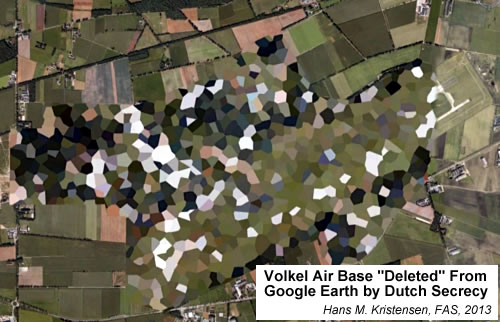
The reason is, the Dutch ministry of defense told me, that an old Dutch law requires that all military and royal (go figure!) facilities be obscured on aerial photos. And because the images covering the Netherlands on Google Earth are supplied by Aerodata International Surveys, a company partly based in Utrecht, the images are sanitized before handed over to Google Earth. It is a pity that a company such as Google lets itself be subjected to silly secrecy by accepting sanitized images on Google Earth.
The law is silly because all national-level adversaries (to Holland) have their own satellite imaging capabilities, so pixel’ing out Volkel AB won’t deny them any information. And anyone else can simply buy high-resolution satellite imagery on the Internet.
To test this point, I went to the web site of AeroGRID, a company partially owned by Aerodata (!). Armed only with a credit card, I was able to purchase a high-resolution image of Volkel Air Base that appeared to show the entire base (see image below).
Problem solved? Not quite. After a closer examination, I discovered that even this “clean” image had also been manipulated, even though AeroGRID never told me that the product I had paid for was actually a fake. Someone had very carefully erased a weapon storage area at the northern part of Volkel AB by overlaying it with trees and farm fields – even inserted forest roads that appear to meet up with dead-end access roads that would otherwise give away that the image had been altered.
Despite these efforts of silly secrecy, I was able to find the secret weapon storage area on another photo that was available on Bing Maps. That photo clearly showed the secret weapons storage area. By overlaying the area from the Bing Maps image onto the AeroGRID image, one can better see the extent of the image manipulation (see image below).
The secret weapons storage area is also visible on a Dutch military base map from 1999 that shows the layout of storage buildings and access roads. Comparison of the map with the Bing Maps image, however, also reveals that the weapons storage loading area has been upgraded significantly (see image below).

This un-redacted image is no longer available on Bing Map, however. Instead, on the new photo that is now available – yes, you guessed it – the weapons storage area has been deleted (see image below).
So why is the weapons storage area at Volkel AB secret? The facility was probably used to store the nuclear weapons until the underground vaults were added to the Protective Aircraft Shelters in 1991. But since then the weapons have been in the vaults. Perhaps they are sometimes serviced in the weapons storage area, or perhaps it’s simply a weapons storage area and therefore automatically considered secret. But now that we know that the weapons storage area is there and what it looks like, there is no need to manipulate the images anymore.
Implications and Conclusions
The confirmation by two former Dutch prime ministers that nuclear weapons are present at Volkel AB is an important contribution to increasing nuclear transparency in Europe. Although it doesn’t tell us something we don’t know, it challenges NATO’s long-standing, outdated, and counterproductive policy of keeping nuclear weapons locations secret. Germany has also confirmed that it hosts nuclear weapons.
Instead of trying to hush things up and continue the secrecy, the Dutch and German governments should together with NATO use the disclosures as an opportunity to reach out to Russia and propose a limited but reciprocal declaration of nuclear weapons storage at Volkel AB, Büchel AB in Germany, and one or two Russian bases. A declaration could be accompanied by verification of the absence of nuclear weapons from one or two bases in each country where nuclear weapons have been removed. Doing so could help jump-start the process of increasing transparency of non-strategic nuclear weapons in Europe, a goal NATO and the Dutch and German governments say they favor. Russia might be interested in exploring such an initiative.
Of course, such a transparency initiative will require the national leadership to twist the arms of the bureaucrats who will oppose any change. But incremental micromanagement of nuclear status quo in Europe will not move the ball forward; it requires political vision and leadership.
Continuing the nuclear secrecy no longer serves a beneficial purpose. The secrecy is not needed for safety or national security; those needs are taken care of by guards, guns, gates, and overall military and political postures. Instead, the secrecy fuels mistrust and rumors that lock NATO and Russia into old mindsets, postures, and relations. The secrecy is also used to chill a public debate that could otherwise result in a demand to withdraw the nuclear weapons from Europe.
One particularly controversial issue that faces the Dutch government and parliament in the next few years is that the B61 bombs at Volkel AB within the next decade are scheduled to be replaced with an improved nuclear bomb that is equipped with a new guidance tail kit that increases the weapon’s accuracy and gives it a standoff capability.
The combination of the new guided standoff B61-12 bomb and the stealthy F-35A Joint Strike Fighter – that the Dutch air force plans to get to replace the F-16 that currently has the nuclear strike mission – will significantly increase the nuclear capability at Volkel AB.
Why does the Dutch government believe it is necessary to begin deploying new guided standoff nuclear weapons at Volkel AB? How will that support the efforts to reduce the numbers and role of nuclear weapons in Europe? How will that help persuade Russia to reduce its non-strategic nuclear weapons?
It would be smart for the Dutch parliament to try to get answers to these questions from the government before the new nuclear bombs and stealth bombers start arriving at Volkel AB.
Background: Non-Strategic Nuclear Weapons (FAS 2012) | US Tactical Nuclear Weapons in Europe, 2011 (BAS 2011) | US Nuclear Weapons in Europe (NRDC 2005)
This publication was made possible by grants from the New-Land Foundation and Ploughshares Fund. The statements made and views expressed are solely the responsibility of the author.
Air Force Briefing Shows Nuclear Modernizations But Ignores US and UK Programs
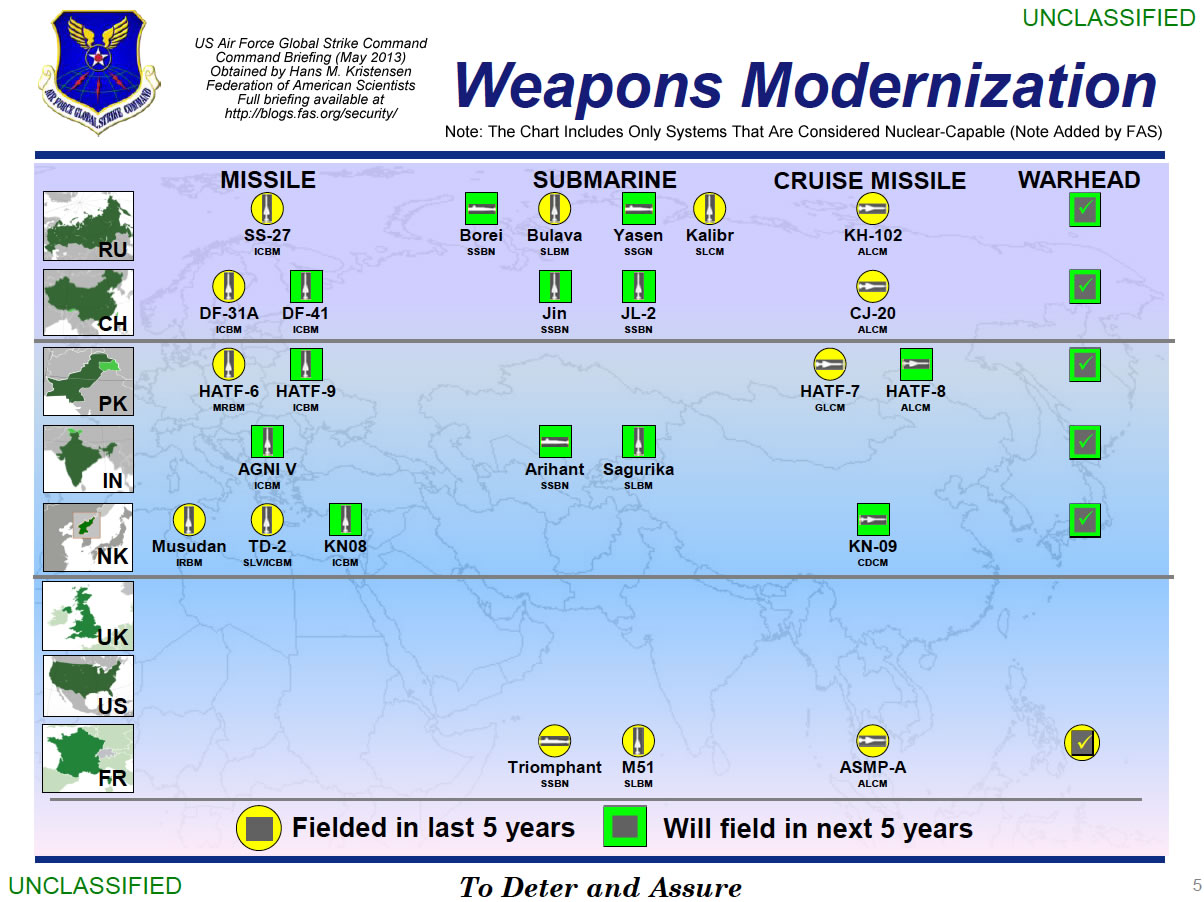
Click to view large version. Full briefing is here.
By Hans M. Kristensen
China and North Korea are developing nuclear-capable cruise missiles, according to U.S. Air Force Global Strike Command (AFGSC).
The new Chinese and North Korean systems appear on a slide in a Command Briefing that shows nuclear modernizations in eight of the world’s nine nuclear weapons states (Israel is not shown).
The Chinese missile is the CJ-20 air-launched cruise missile for delivery by the H-6 bomber. The North Korean missile is the KN-09 coastal-defense cruise missile. These weapons would, if for real, be important additions to the nuclear arsenals in Asia.
At the same time, a closer look at the characterization used for nuclear modernizations in the various countries shows generalizations, inconsistencies and mistakes that raise questions about the quality of the intelligence used for the briefing.
Moreover, the omission from the slide of any U.S. and British modernizations is highly misleading and glosses over past, current, and planned modernizations in those countries.
For some, the briefing is a sales pitch to get Congress to fund new U.S. nuclear weapons.
Overall, however, the rampant nuclear modernizations shown on the slide underscore the urgent need for the international community to increase its pressure on the nuclear weapon states to curtail their nuclear programs. And it calls upon the Obama administration to reenergize its efforts to reduce the numbers and role of nuclear weapons.
Russia
![]()
The briefing lists seven Russian nuclear modernizations, all of which are well known and have been underway for many years. Fielded systems include SS-27 ICBM, Bulava SLBM, Kalibr SLCM, and KH-102 ALCM.
It is puzzling, however, that the briefing lists Bulava SLBM and Kalibr SLCM as fielded when their platforms (Borei SSBN and Yasen SSGN, respectively) are not. The first Borei SSBN officially entered service in January 2013.
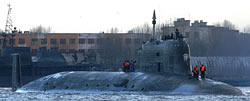
Nuclear Cruise Missile For Yasen SSGN
It is the first time I’ve seen a U.S. government publication stating that the non-strategic Kalibr land-attack SLCM is nuclear (in public the Kalibr is sometimes called Caliber). The first Yasen SSGN, the Severodvinsk, test launched the Kalibr in November 2012. The weapon will also be deployed on the Akula-class SSGN. The Kalibr SLCM, which is dual-capable, will probably replace the aging SS-N-21, which is not. There are no other Russian non-strategic nuclear systems listed in the AFGSC briefing.
A new warhead is expected within the next five years, but since no new missile is listed the warhead must be for one of the existing weapons.
China
![]()
The briefing lists six Chinese nuclear modernizations: DF-31A ICBM, DF-41 ICBM, Jin SSBN, JL-2 SLBM, CJ-20 ALCM, and a new warhead.
The biggest surprise is the CJ-20 ALCM, which is the first time I have ever seen an official U.S. publication crediting a Chinese air-launched cruise missile with nuclear capability. The latest annual DOD report on Chinese military modernization does not do so.
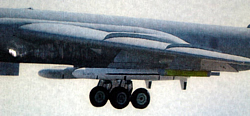
H-6 with CJ-20. Credit: Chinese Internet.
The CJ-20 is thought to be an air-launched version of the 1,500+ kilometer ground-launched CJ-10 (DH-10), which the Air Force in 2009 reported as “conventional or nuclear” (the AFGSC briefing does not list the CJ-10). The CJ-20 apparently is being developed for delivery by a modified version of the H-6 medium-range bomber (H-6K and/or H-6M) with increased range. DOD asserts that the H-6 using the CJ-20 ALCM in a land-attack mission would be able to target facilities all over Asia and Russia (east of the Urals) as well as Guam – that is, if it can slip through air defenses.
The elusive DF-41 ICBM is mentioned by name as expected within the next five years. References to a missile known as DF-41 has been seen on and off for the past two decades, but disappeared when the DF-31A appeared instead. The latest DOD report does not mention the DF-41 but states that, “China may also be developing a new road-mobile ICBM, possibly capable of carrying a multiple independently targetable reentry vehicle (MIRV).” (Emphasis added).
AFGSC also predicts that China will field a new nuclear warhead within the next five years. MIRV would probably require a new and smaller warhead but it could potentially also refer to the payload for the JL-2.
Pakistan
![]()
Pakistan is listed with five nuclear modernizations, all of which are well known: Hatf-8 (Shaheen II) MRBM, Hatf-9 (NASR) SRBM, Hatf-7 (Babur) GLCM, Hatf-8 (Ra’ad) ALCM, and a new warhead. Two of them (Hatf-8 and Hatf-7) are listed as fielded.
The briefing mistakenly identifies the Hatf-9 as an ICBM instead of what it actually is: a short-range (60 km) ballistic missile.
The new warhead might be for the Hatf-9.
India
![]()
India is listed with four nuclear modernizations, all of which are well known: Agni V ICBM, Arihant SSBN, “Sagurika” SLBM, and a new warhead. The U.S. Intelligence Community normally refers to “Sagurika” as Sagarika, which is known as K-15 in India.
Neither the Agni III nor Agni IV are listed in the briefing, which might indicate, if correct, that the two systems, both of which were test launched in 2012, are in fact technology development programs intended to develop the technology to field the Agni V.
The U.S. Intelligence Community asserts that the Agni V will be capable of carrying multiple warheads, as recently stated by an India defense industry official – a dangerous development that could well motivate China to deploy multiple warheads on some of its missiles and trigger a new round of nuclear competition between India and China.
The new warhead might be for the SLBM and/or for Agni V.
North Korea
![]()
North Korea is listed with five nuclear modernizations: Musudan IRBM, TD-2 SLV/ICBM, KN-08 ICBM, KN-09 CDCM, and a warhead.

The biggest surprise is that AFGSC asserts that the KN-09 is nuclear-capable. There are few public reports about this weapon, but the South Korean television station MBC reported in April that it has a range of 100-120 km. MBC showed KN-09 as a ballistic missile, but AFGSC lists it as a CDCM (Coastal Defense Cruise Missile).
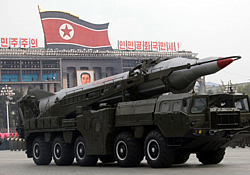
The Musudan IRBM is listed as “fielded” even though the missile, according to the U.S. Intelligence Community, has never been flight tested. In this case, “fielded” apparently means it has appeared but not that it is operational or necessarily deployed with the armed forces.
The Mushudan is listed as “fielded,” similar to the Russian SS-27, even though the North Korean missile has never been flight tested.
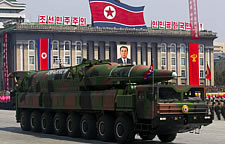
The KN-08 ICBM, which was displayed at the May 2012 parade, was widely seen by non-governmental analysts to be a mockup. But AFGSC obviously believes the weapon is real and expected to be “fielded” within the next five years. There were rumors in January 2013 that North Korea had started moving KN-08 launchers around the country at the beginning of a saber-rattling campaign that lasted through March.
Finally, the AFGSC briefing also predicts that North Korea will field a nuclear warhead within the next five year. Whether this refers to North Korea’s first weaponized warhead or newer types is unclear.
United Kingdom
![]()
The UK section does not include any weapons modernizations, which doesn’t quite capture what’s going on. For example, Britain is deploying the modified W76-1/Mk4A, which British officials have stated will increase the targeting capability of the Trident II D5 SLBM. Accordingly, a warhead icon has been added to the U.K. bar above.
Moreover, although the final approval has not been given yet, Britain is planning construction of a new SSBN to replace the current fleet of four Vanguard-class SSBNs. The missile section is under development in the United States. The new submarine will also receive the life-extended D5 SLBM.
United States
![]()
The U.S. section also does not show any nuclear modernizations, which glosses over important upgrades.
For example, the Minuteman III ICBM is in the final phases of a decade-long multi-billion dollar life-extension program that will extend the weapon to 2030. Privately, Air Force officials are joking that everything except the shell is new. Accordingly, a fielded ICBM icon has been added to the U.S. bar.
Moreover, full-scale production and deployment of the W76-1/Mk4A warhead on the Trident II D5 SLBM is underway. The combination of the new reentry body with the D5 increases the targeting capability of the weapon. Accordingly, a fielded warhead icon has been added to the U.S. bar.
In addition, from 2017 the U.S. Navy will begin deploying a modified life-extended version of the D5 SLBM (D5LE) on Ohio-class SSBNs. Production of the D5LE is currently underway, which will be “more accurate” and “provide flexibility to support new missions,” according to the navy and contractor. Accordingly, a forthcoming SLBM icon has been added to the U.S. bar.
Finally, the United States has begun design of a new SSBN class, a long-range bomber, a long-range cruise missile, a fighter-bomber, a guided standoff gravity bomb, and is studying a replacement-ICBM.
Hardly the dormant nuclear enterprise portrayed in the briefing.
France
![]()
France is listed with four nuclear modernizations, all well known: Triomphant SSBN, M51 SLBM, ASMP-A ALCM, and a new warhead.
The introduction of the ASMP-A is complete but the M51 SLBM is still replacing M45 SLBMs on the SSBN fleet.
The warhead section only appears to include the TNA warhead for the ASMP-A but ignores that France from 2015 will begin replacing the TN75 warhead on the M51 SLBM with the new TNO.
What is Meant by Nuclear and Fielded?
The AFGSC briefing is unclear and somewhat confusing about what constitutes a nuclear-capable weapon system and when it is considered “fielded.”
AFGSC confirmed to me that the slide only lists nuclear-capable weapon systems.
Air Force regulations are pretty specific about what constitutes a nuclear-capable unit. According to Air Force Instruction 13-503 regarding the Nuclear-Capable Unit Certification, Decertification and Restriction Program, a nuclear-capable unit is “a unit or an activity assigned responsibilities for employing, assembling, maintaining, transporting or storing war reserve (WR) nuclear weapons, their associated components and ancillary equipment.”
This is pretty straightforward when it comes to Russian weapons but much more dubious when describing North Korean systems. Russia is known to have developed miniaturized warheads and repeatedly test-flown them on missiles that are operationally deployed with the armed forces.
North Korea is a different matter. It is known to have detonated three nuclear test devices and test-launched some missiles, but that’s pretty much the extent of it. Despite its efforts and some worrisome progress, there is no public evidence that it has yet turned the nuclear devices into miniaturized warheads that are capable of being employed successfully by its ballistic or cruise missiles. Nor is there any public evidence that nuclear-armed missiles are operationally deployed with the armed forces.
Moreover, the U.S. Intelligence Community has recently issued strong statements that cast doubt on whether North Korea has yet mastered the technology to equip missile with nuclear warheads. James Clapper, the director of National Intelligence, testified before the Senate on April 18, 2013, that despite its efforts, “North Korea has not, however, fully developed, tested, or demonstrated the full range of capabilities necessary for a nuclear-armed missile.”
So how can the AFGSC briefing label North Korean ballistic missiles as nuclear-capable – and also conclude that the KN-09 cruise missile is nuclear-capable?
There are similar questions about the determination of when a weapon system is “fielded.” Does it mean it is fielded with the armed forces or simply that it has been seen? For example, how can a North Korean Musudan IRBM be considered fielded similarly to a Russia SS-27 ICBM?
Or how can the Musudan IRBM be identified as already “fielded” when it has not been flight tested and only displayed on parade, when the KN-08 is identified as not “fielded” even though it has also not been flight tested, also been displayed on parade, and even moved around North Korea?
Finally, how can the Russian Bulava SLBM and Kalibr SLCM be listed as “fielded” when their delivery platforms (Borei SSBN and Yasen SSGN, respectively) are listed as not fielded?
These inconsistencies cast doubt on the quality of the AFGSC briefing and whether it represents the conclusion of a coordinated Intelligence Community assessment, or simply is an effort to raise money in Congress for modernizing U.S. bombers and ICBMs.
Implications and Recommendations
There are still more than 17,000 nuclear weapons in the world and all the nuclear weapon states are busy maintaining and modernizing their arsenals. After Russia and the United States have insisted for decades that nuclear cruise missiles are essential for their security, the AFGSC briefing claims that China and North Korea are now trying to follow their lead.
For some, the AFGSC briefing will be (and probably already is) used to argue that nuclear threats against the United States and its allies are increasing and that Congress therefore should oppose further reductions of U.S. nuclear forces and instead approve modernizations of the remaining arsenal.
But Russia is not expanding its nuclear forces, the nuclear arsenals of China and Pakistan are much smaller than U.S. forces, and North Korea is in its infancy as a nuclear weapon state.
Instead, the rampant nuclear modernizations shown in the briefing symbolize struggling arms control and non-proliferation regimes that appear inadequate to turn the tide. They are being undercut by recommitments of a small group of nuclear weapon states to retain and improve nuclear forces for the indefinite future. The modernizations are partially being sustained by non-nuclear weapon states – often the very same who otherwise say they want nuclear disarmament – that insist on being protected by nuclear weapons.
The AFGSC briefing shows that there’s an urgent need for the international community to increase its pressure on the nuclear weapon states to curtail their nuclear programs. Especially limitations on MIRVed missiles are urgently needed. For its part, the Obama administration must reenergize its efforts to reduce the numbers and role of nuclear weapons.
There have been many nice speeches about reducing nuclear arsenals but too little progress on limiting the endless cycle of modernizations that sustain them.
Document: Air Force Global Strike Command Command Briefing
This publication was made possible by grants from the New-Land Foundation and Ploughshares Fund. The statements made and views expressed are solely the responsibility of the author.
Chinese Nuclear Developments Described (and Omitted) by DOD Report
By Hans M. Kristensen
Going, going, gone! In its latest annual report to Congress on the military and security developments of the People’s Republic of China, the Pentagon has removed the last public authoritative overview of Chinese nuclear forces.
Until 2010, the annual reports included a table with a detailed breakdown of the different types of ballistic missiles that enabled the public to monitor the development of China’s nuclear modernization. In 2011, however, things began to change when a less detailed table was included that only showed overall categories of missiles. That version appeared in 2012 as well, but the 2013 report includes no table at all of China’s missile forces.
The tidbits of information left in the report indicate an ICBM force that is modernizing but leveling out and an SSBN force that is approaching functional capability.
Land-Based Nuclear Forces
DOD reports the same number of ICBMs as last year, 50-75. The Pentagon considers a missile with a range of at least 5,500 km to be an ICBM, so this number includes the DF-5A, DF-31A, DF-31 and DF-4. Of these, only the DF-5A and DF-31A can reach the continental United States.
The 50-75 ICBMs is the same number DOD has reported for the past three years, which indicates that the ICBM force level has leveled out for now. But DOD predicts that additional DF-31As will be deployed over the next two-three years.
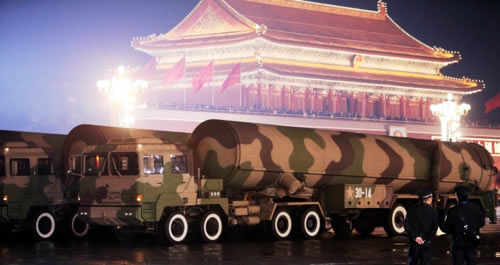
The report also repeats the prediction from previous years that China “may also be developing” a new road-mobile ICBM that is “possible capable of” carrying MIRVed warheads. The U.S. Intelligence Community has for several decades assessed that China has a capability to develop and deploy MIRV but that it has not yet done so. One sentence in the report comes close to saying that that’s about to change with “The new generation of mobile missiles, with warheads consisting of MIRVs and penetration aids,” but the report does not confirm widespread rumors (see here and here) that a 10-warhead DF-41 ICBM was test launched last year. All appeared to feed off this article. Many MIRV reports appear to confuse warheads with decoys and penetration aids.
The report does not provide an update of nuclear medium-range missiles, except confirming that a few aging liquid-fuel DF-3As are still operational. They will likely be retired within the next few years.
As one would imagine, the new and increasingly mobile missile force requires updating the command and control system. The DOD report states that China has done so and states that “improved communications links” means that “the ICBM units now have better access to battlefield information, uninterrupted communications connecting all command echelons, and the unit commanders are able to issue orders to multiple subordinates at once, instead of serially via voice commands.”
At the same time, further increases in the number of mobile ICBMs, the DOD report states, “will force the PLA to implement more sophisticated command and control systems and processes that safeguard the integrity of nuclear release authority for a larger, more dispersed force.”
Sea-Based Nuclear Forces
The DOD report states that China has added a third Jin-class (Type 094) SSBN to its fleet and that two more are in various stages of construction. Their nuclear ballistic missile, the Julang-2, is not yet operational, however, but the report indicates that has missile program has overcome technical difficulties, completed a series of successful testing in 2012, and appears ready to reach initial operational capability in 2013.
There is no confirmation of the rumor that the JL-2 has a capability to carry multiple warheads.
The single Xia-class (Type 92) SSBN that China built back in the early 1980s has never been fully operational. It is still afloat, moored at the Jianggezhuang naval base near Qingdao in the Shandong province. The boat will likely be retired, along with its Julang-1 SLBMs, once the Jin-class SSBNs become fully operational.
Moreover, the report predicts that China within the next decade might begin construction of a new class of SSBNs, known as the Type 096. If so, that suggests that the Jin-class design may not have been considered a success.
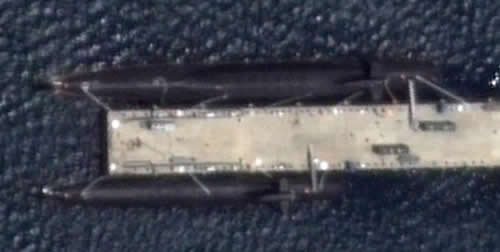
A Jin-class (top) ballistic missile submarine and Shang-class attack submarine are seen docked at the naval base near Longpo on Hainan Island in this DigitalGlobe/GoogleEarth satellite image from June 27, 2012. Jin-class SSBN were first seen at Hainan in February 2008.
Once fully operational, the DOD report states, SSBNs based at Hainan Island “would then be able to conduct nuclear deterrence patrols.” But now China will operate the SSBN fleet remains to be seen. It might begin to mimic deterrence patrols of other nuclear weapon states, but it seems unlikely that China will begin to deploy nuclear-armed missiles on its SSBNs under normal circumstance because the Central Military Commission is unlikely to hand over nuclear warheads to the armed forces unless in an emergency.
Moreover, Chinese SSBNs are relatively noisy (see graph below) and vulnerable to enemy anti-submarine capabilities, so it seems contrary to China’s core strategic objective of protecting its retaliatory nuclear capability to send some of it out to sea where it can be sunk by enemy attack submarines.
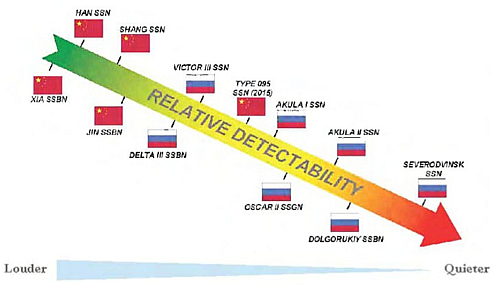
This vulnerability is compounded by the fact that Chinese SSBNs have never conducted a deterrence patrol (see below), which makes the Chinese navy woefully inexperienced in operating an SSBN effectively and safely.
Data obtained from U.S. Naval Intelligence under the Freedom of Information Act shows that Chinese missile submarines have never conducted a deterrent patrol. The attack submarine fleet is more active, with patrols having more than quadrupled over the past decade from around four per year to approximately eighteen patrols last year (see graph).
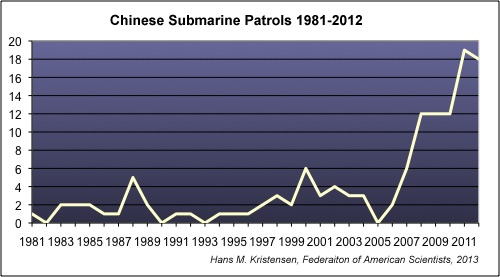
The increase in general-purpose submarine patrols has coincided with the introduction of the Chang-class (Type 093) nuclear-powered attack submarine (SSN) from 2005, but probably also reflects operations by more advanced diesel-electric submarines. The introduction of Type 093 SSNs has been slow, however, with only two in service and four improved version under construction to replace the remaining aging first-generation Han-class (Type 091) class SSNs.
Within the next decade, the DOD report predicts, China will likely begin construction of a new class of nuclear-powered attack submarines (Type 096), which might be equipped with land-attack cruise missiles.
Air-Based Nuclear Forces
The DOD report does not explicitly credit the Chinese air force with a nuclear capability but it probably has a limited secondary mission with nuclear gravity bombs. The H-6 medium-range bomber was used to carry out a dozen nuclear tests in the 1970s and 1980s.
The report states that China is modifying the H-6 to “a new variant that possesses greater range and will be armed with a long-range cruise missile.” Elsewhere the report states that H-6 upgrades “may provide the capability to carry new, longer-range cruise missiles.” So whether the H-6 upgrades involve one or more types of long-range cruise missiles is a little unclear.
So far the air-launched cruise missiles have not been credited with nuclear capability, although the ground-launched DH-10 (which is not mentioned in the DOD report) was described as “conventional or nuclear” by the Air Force National Air and Space Intelligence Center in 2009.
Conclusions and Implications
Chinese nuclear modernizations continue with modest pace with focus on safeguarding a retaliatory capability by replacing land-based liquid-fuel missiles with solid-fuel versions, increasing mobile ICBMs, and building a small fleet of ballistic missile submarines.
The size of the ICBM force appears to be leveling out for now, although more may be deployed in the future. And once the 36 JL-2 SLBMs on the three Jin-class SSBNs become operational, they will increase the Chinese nuclear ballistic missile force by approximately 27 percent compared with the current inventory.
Yet because older types are also being retired, the impact on the size of the total nuclear weapons stockpile so far appears to be modest. Earlier this year, Assistant Secretary of Defense for Global Affairs, Madelyn Creedon, testified before the Senate that despite China’s nuclear force modernizations, “we estimate that it has not substantially increased its nuclear warhead stockpile in the past year…” Moreover, STRATCOM Commander General Kehler last year rejected claims by some that China has hundreds or thousands more nuclear weapons than the “several hundred” estimated by the U.S. Intelligence Community.
The complete deletion of the table overview of China’s missile forces is striking because the Pentagon for years has been complaining about a lack of transparency in China’s military modernization. Ironically, this complaint was repeated when the Pentagon briefed this year’s report. Said Deputy Assistant Secretary of Defense for East Asia, David Helvey:
“So what – what concerns me – is the extent to which China’s military modernization occurs in – in the absence of the type of openness and transparency that others are certainly asking of China and the potential implications and consequences of that lack of transparency on the security calculations of others in the region. And so it’s that uncertainty, I think, that’s of greater concern.”
Instead of assisting Chinese nuclear secrecy, the United States should push for transparency and accountability. Authoritative overviews of Chinese nuclear force developments are important to enable the public to assess implications of China’s nuclear modernization and to counter attempts by those who use the uncertainty created by lack of information to hype the threat in order to justify excessive military spending.
This publication was made possible by grants from the New-Land Foundation and Ploughshares Fund. The statements made and views expressed are solely the responsibility of the author.
Talk At US Air Force Global Strike Command
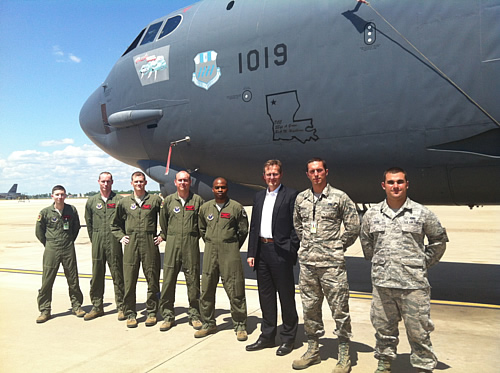
Kristensen on the tarmac at Barksdale Air Force Base with the crew of the nuclear-capable B-52H bomber “Rolling Thunder” (61-019) from the 96th Bomb Squadron that recently flew B-52 bombers over South Korea.
By Hans M. Kristensen
Earlier this week I went to Barksdale AFB on an invitation from General Jim Kowalski at Air Force Global Strike Command to brief his Deterrence and Assurance Working Group.
Air Force Global Strike Command (AFGSC) is responsible for keeping U.S. strategic bombers (B-2 and B-52) and Intercontinental Ballistic Missiles (ICBMs) combat ready. One of two B-52H wings, the 2nd Bomb Wing, is based at Barksdale AFB, as is 8th Air Force Headquarters.
Barksdale AFB has a special history because it was there, in August 2007, that a B-52 arrived from Minot AFB with six nuclear-armed Advanced Cruise Missiles strapped under its wings without anyone knowing about it.
It was a great visit. The staff did a superb job hosting me, and Gen. Kowalski and his wife Julie were the most generous hosts. But they sure kept me busy:

After getting woken up by the base bugle, I was brought to base headquarters for a one-on-one briefing by Gen. Kowalski on the mission of AFGSC. He told me about the capabilities of the command, the nuclear forces of the United States and other nuclear weapon states, nuclear modernization, as well as budget and costs issues.
After a swing by the base museum and a lunch with Gen. Kowalski and 18 members of the senior leadership, the General Larry Welch briefing room filled up with an additional 34 military and civilian officials for my talk.
In my talk I advocated further reductions of nuclear weapons, arguing that deterrence and assurance could be sustained at significantly lower levels. I pointed to the very different nuclear forces of different countries as examples of other countries ensuring their security with much smaller nuclear forces. And I predicted that new presidential guidance would probably reduce the force level further in the near future. Despite obvious disagreements, the discussion was courteous.
After the talk, they brought me out on the tarmac where the crew of a nuclear-capable B-52H from the 96th Bomb Squadron gave me a briefing and a tour of the inside. Its nuclear weapons are not stored at Barksdale AFB but up at Minot AFB. The 96th Bomb Squadron returned in April from a six-month deployment to Guam, during which some of the B-52Hs overflew the Korean Peninsula to deter North Korea and assure South Korea.
Next stop was the B-52 simulator where my co-pilot gave a few instructions, after which we powered up the six engines and took off, flew a brief tour over northern Louisiana, and returned to base (without crashing).
A cozy dinner in the beautiful home of Mr. and Mrs. Kowalski ended what had been an exciting visit with fascinating discussions with some of the men and women who operate America’s nuclear forces.
Download: Prepared remarks to U.S. Air For Global Strike Command Deterrence and Assurance Working Group
Declining Deterrent Patrols Indicate Too Many SSBNs
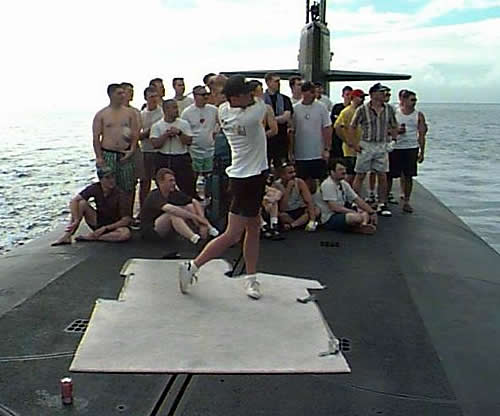
By Hans M. Kristensen
Does the U.S. Navy have more ballistic missile submarines than it needs? Dramatic reductions in deterrent patrols – but not submarines – suggest so.
Over the past thirteen years, the number of deterrent patrols conducted each year by U.S. ballistic missile submarines (SSBNs) has declined by more than half.
During most of the same period, the size of the SSBN fleet has remained relatively steady at 14 boats, after four were retired in 2001-2003. Yet the decline in deterrent patrols has continued.
As a result, each SSBN now conducts one deterrent patrol less per year, in average, than it did a decade ago. At any given time, there are fewer SSBNs on deterrent patrol today than in the early-1960s when SSBN patrols first began.
The development indicates that the U.S. Navy may currently be operating more SSBNs than are needed for U.S. security needs, and that the current patrol rate could in fact be maintained with fewer submarines.
This also raises questions about the navy’s plan to build a new class of 12 SSBNs to replace the current class of 14 Ohio-class SSBNs. Fewer than 12 submarines would be able to meet the current deterrent patrol level and the number of patrols may even decline further in the future.
Declining Deterrent Patrols
Since 1999, the number of deterrent patrols the U.S. SSBN fleet conducts each year has declined by more than 56 percent from 64 patrols in 1999 to 28 in 2012. The decline has reduced the number of annual patrols to the lowest level since 1962 (see graph).
The decline has been most significant in the Atlantic where the number of annual patrols has dropped from 34 in 1999 to only 10 in 2012, a decline that was expected because King’s Bay has lost four SSBNs since 1999 and now operates only six boats.
But even in the Pacific, where most SSBNs are now based and the fleet has remained steady at eight boats, the decline has also been significant, from 30 patrols in 1999 to 18 patrols in 2012.
Effects on Operational Tempo
Ohio-class SSBNs were optimized for long deterrent patrols and each boat has two crews (Gold and Blue) to enable the submarines to spend as little time in port as possible.
Yet each SSBN now spends less than half of the year on deterrent patrol – the purpose for which it was built – compared with 60-70 percent a decade ago. The decline means that each submarine today conducts an average of 2.3 deterrence patrols per year, down from 4.1 a decade ago. In fact, today’s patrol rate is the lowest ever for the Ohio-class SSBNs.
Each patrol lasts an average of 70 days but the duration can fluctuate significantly, from as little as 30 days to more than 100 days, due to targeting requirements and technical issues.
The longest-ever known patrol conducted by a U.S. SSBN took place in 2010 when the USS Maine (SSBN-741) deployed continuously for 105 days between August and December.
Patrol Rate Versus At-Sea Rate
The decline in deterrent patrols should theoretically result in 5-6 SSBNs (36-43 percent) deployed at any given time and the remaining 8-9 boats visible in port. But the patrol rate does not match the at-sea rate; there are more SSBNs at sea than on patrol.
Between 1998 and 2001, the U.S. Navy periodically disclosed how many SSBNs were at sea at any given time: an average of 11 boats out of a fleet of 18 SSBNs (about 61 percent). The terrorist attacks in September 2001 put an end to that transparency and subsequent requests to the navy for the information were denied.
Yet high-resolution commercial satellite images have since become widely available to the general public via Google Earth and other sources. Examination of more than two dozen satellite images from 1993-2012 shows that an average of ten SSBNs (71 percent) are normally absent from the two bases. Two of those SSBNs are in dry dock for refueling while the remaining eight (57 percent) are deployed at sea.
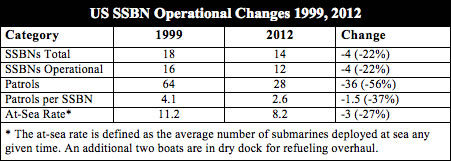
So why doesn’t the patrol rate not match the at-sea rate? The reason is that deterrent patrols are not the only thing that SSBNs do. Between patrols and maintenance, each submarine deploys on sea-trials, midshipmen cruises and exercises. Yet the decline in deterrent patrols means that SSBNs are now doing more of the other things than they did a decade ago.
Fewer SSBNs Can Do The Job
The dramatic decline in deterrent patrols over the past decade suggests that the U.S. Navy can meet its deterrence requirements with fewer SSBNs than the 14 boats it currently operates. In fact, if each SSBN conducted as many patrols as a decade ago, no more than eight operational SSBNs would be needed to conduct the 28 deterrent patrols required today. With two additional SSBNs in refueling overhaul at any given time, the fleet could be reduced from 14 to 10 boats, saving millions of dollars in operational, maintenance, personnel, and inspections.
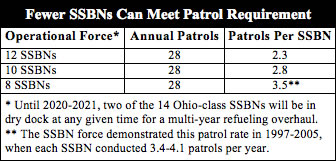
Even if the navy needed to retain an additional two SSBNs as a couching against technical problems, the fleet could probably be reduced to 12 boats. Indeed, the 2010 Nuclear Posture Review forecasts such a reduction:
Depending on future force structure assessments, and on how remaining SSBNs age in the coming years, the United States will consider reducing from 14 to 12 Ohio-class submarines in the second half of this decade. This decision will not affect the number of deployed nuclear warheads on SSBNs.
The reason a reduction of two submarines would not affect the number of deployed nuclear warheads on SSBNs is that the two “reduced” SSBNs are the ones that are not deployed but in dry dock for refueling at any given time. The last of those multi-year refueling overhauls is scheduled for the end of this decade, so the NPR projection appears to make a virtue out of necessity. Indeed, unless the two submarines are retired, the navy would actually operate 14 deployed SSBNs during most of the 2020s, or more than is required for national security.
The navy is planning a new generation of 12 SSBNs to replace the current 14 Ohio-class SSBNs. The new submarine will have a new reactor core that can last the entire life of the ship; no multi-year refueling overhaul will be needed (individual submarines will still need to go into dry dock for shorter periods for maintenance and upgrades). The new SSBNs will also be equipped with a new electrical drive and probably be significantly quieter than the Ohio-class. These factors will allow additional reductions.
Moreover, the next-generation SSBNs will only carry 16 missiles each, down from 24 today and 20 by 2018. The first new SSBN will not deploy on patrol until 2031 but it nonetheless indicates that U.S. Strategic Command has already determined that there are 30 percent too many sea-launched ballistic missiles. “The Milestone A decision [12 SSBNs with 16 missiles each] did not assume any specific changes to targeting or employment guidance,” STRATCOM commander Robert Kehler testified before Congress in November 2011. If so, why continue to deploy with the extra missiles for another two decades?
The eight SSBNs that are currently at sea carry 192 missiles with an estimated 860 warheads. Of those, four-five SSBNs with 96-120 missiles and 430-540 warheads are on alert holding targets at risk in Russia, China and North Korea. Eight next-generation SSBNs could carry the same number of warheads on 128 missiles by increasing the warhead loading on each missile. But by 2031, nearly two decades from now, the targeting requirement is likely to be lower than today.
Conclusions and Implications
The significant reduction in SSBN deterrent patrols over the past decade suggests that the U.S. Navy currently operates more SSBNs than are needed.
Compared with a decade ago, each submarine is doing less of what it was designed to do – conducting deterrent patrol with ready nuclear weapons – and spending more time in port and on exercises.
The declining deterrent patrols, combined with a decision to reduce the number of sea-launched ballistic missiles by a third over the next two decades without reduced targeting requirements, indicate that the current SSBN posture is bloated and in excess of national security needs.
The navy could easily cut the SSBN fleet from 14 to 12 boats now and reduce the requirement for the next-generation SSBN from 12 to 10 boats and save billions of dollars in the process.
This publication was made possible by a grant from the Ploughshares Fund. The statements made and views expressed are solely the responsibility of the author.
PREPCOM Nuclear Weapons De-Alerting Briefing

By Hans M. Kristensen
Greetings from Geneva! I’m at the Palais des Nations for the second Preparatory Committee (PREPCOM) meeting for the 2015 Review Conference of the nuclear Non-Proliferation Treaty (NPT). I was invited by the Swiss and New Zealand UN Missions to brief our report Reducing Alert Rates of Nuclear Weapons.
With me on the panel was Richard Garwin, an FAS board member who for more than five decades has advised U.S. governments on nuclear weapons and other issues, and Gareth Evans, former Australian Foreign Minister and now Chancellor of the Australian National University.
The panel was co-chaired by Ambassador H.E. Dell Higgie, the head of the New Zealand UN Mission and Permanent Representative to the United Nations and Conference on Disarmament, and Ambassador Benno Laggner, the head of the Swiss Foreign Ministry’s Division for Security Policy and Ambassador for Nuclear Disarmament and Non-Proliferation. Switzerland and New Zealand have for several years spearheaded efforts in the United Nations to reduce the alert level of nuclear weapons.
I wrote the de-alerting report together with Matthew McKinzie who directs the nuclear program at the Natural Resources Defense Council. Click to download my briefing slides (7.6 MB) and prepared remarks.
B-2 Stealth Bomber To Carry New Nuclear Cruise Missile
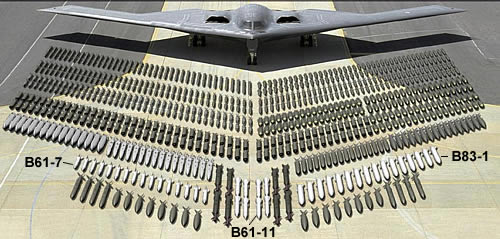
By Hans M. Kristensen
The U.S. Air Force plans to arm the B-2A stealth bomber with a new nuclear cruise missile that is in the early stages of development, according to Air Force officials and budget documents.
The B-2A bomber, which is designed to slip through air defenses undetected, does not currently have a capability to deliver nuclear cruise missiles, a role reserved exclusively for B-52H bombers.
Under the Air Force’s plans, however, the new nuclear cruise missile – known as the Long-Range Standoff Weapon – will arm three nuclear bombers: the B-2A, the B-52H, and the next-generation Long-Range Strike Bomber.
Recent Statements
The disclosure that the new nuclear cruise missile will be carried on the B-2A, B-52H, as well as the next generation bomber has emerged in recent Air Force testimony to Congress, the Air Force’s FY2014 budget request, and in a little notice interview in Air Force Magazine.
Maj. Gen. Garrett Harencak, assistant chief of staff for Air Force strategic deterrence and nuclear integration, informed Congress last week that the Long-Range Standoff (LRSO) nuclear cruise missile “will be designed at its outset to be compatible with B-52, B-2, and the LRS-B” (Long-Range Strike-Bomber).
Lieutenant General James Kowalski, the commander of Air Force Global Strike Command, confirmed: “The LRSO will be the follow-on to the aging ALCM and will be compatible with the B-52, B-2 and LRS-B.”
The Air Force budget request for FY2014 reveals that integration on the B-2 is already underway as part of a program known as Flexible Strike:
B-2 armament upgrades integrate new and/or advanced weapons on the B-2 to address a wider array of target sets, to include moving targets, and hardened, deeply buried targets. The Flexible Strike Phase 1 program — formerly known as Stores Management Operational Flight Program re-host — will recombine and rehost the current B-2 stores management software onto a new integrated processor, providing the processing and bandwidth to handle advanced digital weapons such as B61-12 or Long Range Stand Off (LRSO).
Production and fielding of the Flexible Strike Phase 1 program is planned for FY2016-FY2017, in time to receive the new guided B61-12 bomb in 2019 and the LRSO cruise missile in the mid/late-2020s.
An Expensive New Nuclear Weapon
In the public debate about the cost of nuclear weapons modernizations, it is often said that the new long-range strike bomber is not a significant nuclear cost because most of its mission is non-nuclear. But that ignores the expensive nuclear payloads (B61-12 and LRSO) that are intended to arm the new bomber.
The full cost of the new nuclear cruise missile is not known yet, because it will not become operational until the mid/late-2020s. But the budget projections in the FY2014 budget request indicate that it will be a very expensive weapon system.
Over the next five years alone, design and development costs for the missile are expected to reach more than $1 billion. Costs will presumably continue to accumulate significantly through the mid/late-2020s as full-scale production and delivery of the weapon get underway.
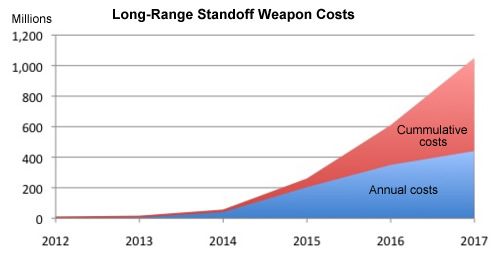
In addition to the cost of the missile itself, the production of the nuclear warhead will add even more. Rather than a new warhead, the Air Force plans to use a life-extended version of an existing warhead: W80-1, W84, or the B61. If other life-extension programs are any indication, then the LRSO warhead program can be expected to cost several billion dollars.
The Mission
The B-2A bomber is designed to penetrate air defenses undetected. So why would the Air Force want to add a nuclear cruise missile to its mission? The answer appears to be that expected improvements in enemy air defense systems by 2030 will make the stealth bomber less stealthy and that a standoff capability therefore is needed for the nuclear strike mission.
When deployed on the B-2A, the LRSO will give the stealth bombers a nuclear standoff capability to carry out missions in heavy air defense environments, according to Billy Mullins, the associated director of strategic deterrence and nuclear integration on the Air Staff.
But that doesn’t quite explain why the Air Force has decided to make the new cruise missile compatible with all three bombers. After all, the B-52H already provides a standoff capability. Perhaps the LRSO will be dual-capable (although this has not been stated) or that the Air Force has simply decided to add a new nuclear cruise missile to all three bombers to provide maximum flexibility.
The new nuclear cruise missile will probably have extended range and stealth features similar to or better than the Advanced Cruise Missile (ACM) that the Air Force retired in 2007. The Air Force states that LRSO “will be capable of penetrating and surviving advanced Integrated Air Defense Systems (IADS) from significant stand off range to prosecute strategic targets in support of the Air Force’s global attack capability and strategic deterrence core function.”
Expanding Nuclear Capabilities
Since the B-2A does not currently carry nuclear cruise missiles, which are exclusively for B-52H bombers, but only gravity bombs (B61-7, B61-11, and B83-1), adding the LRSO will significantly increase the military capability of the B-2A weapon system.
Moreover, adding LRSO capability to all three bombers would be a significant expansion of the nuclear cruise missile capacity of the U.S. bomber fleet. Currently, some 528 ALCMs are assigned to 44 B-52H bombers in four squadrons of the 2nd and 5th Bomb Wings. In the future, also the 509th Bomb Wing at Whiteman AFB would also receive nuclear cruise missiles, as would the bases that receive the next-generation bomber.
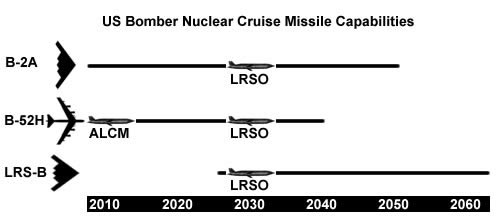
Most important in term of capability, perhaps, is the transition of nuclear cruise missiles onto stealth platforms (B-2A and LRS-B) that have a much better penetration capability than the current cruise missile carrier (B-52H). This will significantly change where and when in a conflicts nuclear cruise missiles can be used, an enhancement that will be boosted even further by the fact that the LRSO cruise missile probably will be more advanced than the ALCM it replaces.
It seems a bit strange, though, to spend money adding LRSO capability to the B-52H because that bomber is scheduled to retain the ALCM to 2030 and retire only 10 years later. The ALCM is currently undergoing refurbishment to ensure that it can remain in service through the 2020s.
Overall, the nuclear capability of the bomber force is expected to change significantly over the next couple of decades as older weapons are retired and new ones added. In addition to the new LRSO, this includes the new guided B61-12 bomb and the possible retirement of the B61-7 and B83-1 bombs.
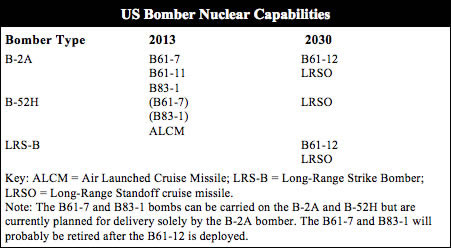
Eventually, both the B-2A and B-52H (as well as the non-nuclear B-1B) will be replaced by a fleet of 100 Long-Range Strike Bombers. Probably not all of them will be nuclear-capable, though, but perhaps half equipped with the B61-12 and LRSO nuclear weapons.
Implications and Recommendations
The implications of adding nuclear cruise missile capability to the B-2A stealth bomber are many. They include improved military capabilities, extensive costs, and the international perception of what U.S. nuclear arms control policy is in the 21st century.
If one believes that a nuclear cruise missile is still needed, a better and less expensive alternative would be to only add LRSO capability to the next-generation bomber and phase out the nuclear capability of B-52H when the current ALCM retires around 2030.
Either way, deploying an improved nuclear cruise missile on improved stealthy bombers appears to challenge the Obama administration’s promise to reduce the role of nuclear weapons and not to add military capabilities during life-extension programs.
The United States is not alone in the continued modernization of nuclear weapons. Russia is also building a new nuclear cruise missile for its bombers, and China is adding cruise missiles to some of its intermediate-range bomber (although there is no indication yet that they are nuclear). France has just introduced a new nuclear cruise missile on its fighter-bombers, and Pakistan is working on two nuclear cruise missiles for its aircraft.
These are only a fraction of the nuclear modernizations underway in all the nuclear weapons states. All hold speeches about ending nuclear arms competition, reducing the numbers and role of nuclear weapons, and pursuing a world free of nuclear weapons, yet all continue to do what they have always done: building and deploying new nuclear weapons.
This publication was made possible by a grant from the Ploughshares Fund. The statements made and views expressed are solely the responsibility of the author.
Chinese ICBM Force Leveling Out?

By Hans M. Kristensen
The size of China’s intercontinental ballistic missile (ICBM) force appears to be leveling out instead of increasing.
During Thursday’s Senate Armed Services Committee hearing on Current and Future Worldwide Threats, Defense Intelligence Agency (DIA) director Lieutenant General Michael T. Flynn told the lawmakers:
China’s nuclear arsenal currently consists of approximately 50-75 ICBMs, including the silo-based CSS-4 (DF-5); the solid-fueled, road-mobile CSS-10 Mod 1 and 2 (DF-31 and DF-31A); and the more limited CSS-3 (DF-3) [sic*].
The force level of 50-75 ICBMs is the same as the U.S. Defense Department reported in 2012 and 2011, slightly up from a medium estimate of 55-65 ICBMs reported in 2010 and rising since the DF-31 and DF-31A first started deploying in 2006-2008. But instead of continuing to increase, the force level estimate has been steady for the past three years at a medium estimate of about 63 ICBMs.
Of the 50-75 ICBMs reported for the past three years, “less than 50” can reach the continental United States, according to DIA. Twenty of those are the silo-based DF-5A. That means that China has deployed fewer than 30 DF-31As, six years after it first started fielding the new missile. DOD stopped providing detailed breakdowns of the Chinese missile force in 2011, but the actual DF-31A number might only be around 20 (2-3 brigades) because the total ICBM estimate also includes DF-4 and DF-31, neither of which can reach the continental United States from their deployment areas in China.
This year’s DIA assessment does not include the prediction from previous years that the number of Chinese ICBMs that can strike the continental United States “probably will more than double…by 2025” to around 100 missiles. This estimate has continued to slide. In 2001 CIA predicted deployment of 75-100 ICBMs “deployed primarily against the United States” by 2015, a prediction that seems in doubt if the the current trend continues.
This year’s DIA threat assessment is also interesting because it doesn’t mention the fabled DF-41, a possible MIRVed ICBM that was rumored to have been test-launched in August 2012. Nor are any of the other new potential launchers identified.
Finally, introduction of China’s new Jin-class SSBN continues to slide; DIA projects the ballistic missile submarine “may reach initial operational capability around 2014,” or four-seven years later than the intelligence community predicted in 2006. Apparently, there have been problems with the Julang-2 missile.
* Note: The designation “DF-3” for the CSS-3 is a typo. It should have been DF-4, for the ageing 5,400-km liquid-fueled ICBM. The DF-3 is an intermediate-range, liquid-fueled ballistic missile that is being retired. Neither the DF-3 nor the DF-21, a more modern medium-range ballistic missile, is mentioned in the testimony.
This publication was made possible by a grant from the Ploughshares Fund. The statements made and views expressed are solely the responsibility of the author.
$1 Billion for a Nuclear Bomb Tail
The U.S. Air Force plans to spend more than $1 billion on developing a guided tailkit to increase the accuracy of the B61 nuclear bomb.
The cost is detailed (to some extent) in the Air Force’s budget request for FY2014, which shows development and engineering through FY2014 and full-scaled production starting in FY2015.
The annual costs increase by nearly 200 percent from $67.9 million in FY2014 to more than $200 million in FY2015. The high cost level will be retained for three years until the project decreases after production ceases in FY2018. Some additional funding is needed after that to complete the integration and certification on (see graph).
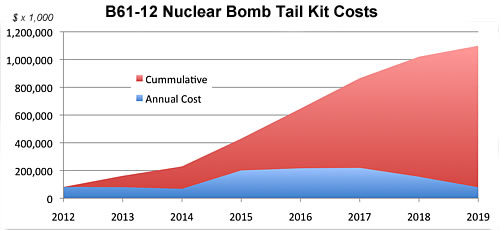
Production of the guided tailkit is intended to match completion of the first new B61-12 bomb in 2019, a program that is estimated to cost more than $10 billion. Although the number is a secret, it is thought that the U.S. plans to produce roughly 400 B61-12s.
The expensive guided tailkit is needed, advocates claim, to make it possible to use the 50-kiloton nuclear explosive package from the tactical B61-4 bomb in the new B61-12 against targets that today require the 360-kiloton strategic B61-7 bomb. By increasing accuracy, the B61-12 becomes more useable because it significantly reduces the amount of radioactive fallout created in an attack.
Once deployed in Europe, the B61-12 will also be able to hold at risk targets that the B61-3 and B61-4 bombs currently deployed in Belgium, Germany, Italy, Netherlands, and Turkey cannot target.
The B61-12 program will maintain compatibility on all five current B61-capable aircraft (B-2A, B-52H, F-16, F-15E and PA 200). In 2015, integration, design and testing will begin on the new stealthy F-35A Joint Strike Fighter. The Air Force budget request shows that B61-12 integration is scheduled for Block 4A and Block 4B aircraft in 2015-2021 with full operational capability in 2022 – three years after the first B61-12 is scheduled to be delivered (see table).
The combination of the new and more accurate guided B61-12 on the stealthy F-35A will significantly increase the capability of the U.S. non-strategic nuclear posture in Europe. This development is out of tune with U.S. and NATO pledges to reduce the role and reliance on nuclear weapons, and will make it a lot easier for hardliners in the Russian military to reject reductions of Russia’s larger inventory of non-strategic nuclear weapons.
This publication was made possible by a grant from the Ploughshares Fund. The statements made and views expressed are solely the responsibility of the author.
